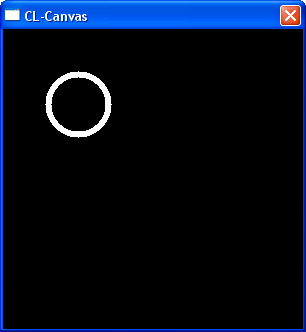
Like with line drawings in Functional Geometry, you can generate nice textures when using functions, which creates functions, which takes the current point for an image to calculate as a parameter. For interactive testing I'm using CL-Canvas.
Lets start with a circle:
(clc:show-canvas 300 300) (defparameter c1 (circle :x0 -0.5 :y0 -0.5 :radius 0.2 :line-width 0.02)) (paint c1)

Some more circles, added together:
(defparameter c2 (circle :x0 0.0 :y0 -0.5 :radius 0.2 :line-width 0.02)) (defparameter c3 (circle :x0 0.5 :y0 -0.5 :radius 0.2 :line-width 0.02)) (defparameter c4 (circle :x0 -0.25 :y0 -0.3 :radius 0.2 :line-width 0.02)) (defparameter c5 (circle :x0 0.25 :y0 -0.3 :radius 0.2 :line-width 0.02)) (defparameter olympic (add c1 c2 c3 c4 c5)) (paint olympic)
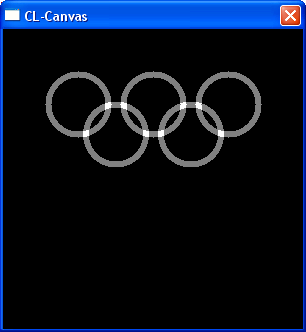
Convert to black and white:
(defparameter olympic-bw (black-white :function olympic :limit 0.5)) (paint olympic-bw)
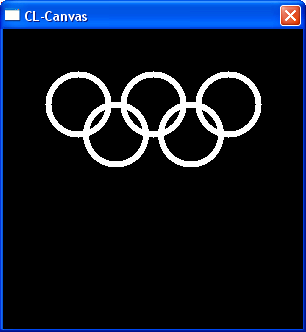
Add an emboss effect:
(defparameter embossed-rings (emboss :function olympic-bw :sample-radius 0.01)) (paint embossed-rings)
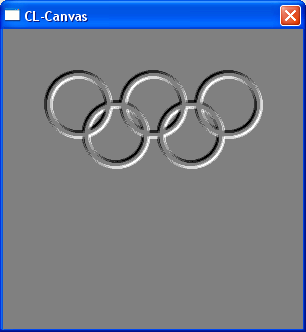
Fill the center again with the original circle, to make it brighter:
(defparameter added-rings (add olympic-bw embossed-rings)) (paint added-rings)
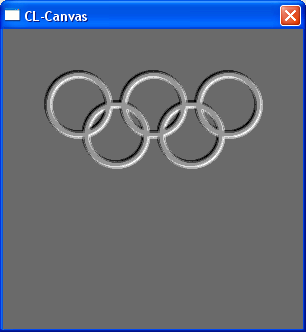
And finally some blur for a more naturally looking:
(defparameter olympic-rings (blur :function added-rings :sample-radius 0.007)) (paint olympic-rings)

Because it is calculated by formulas, you can scale it lossless to every size:
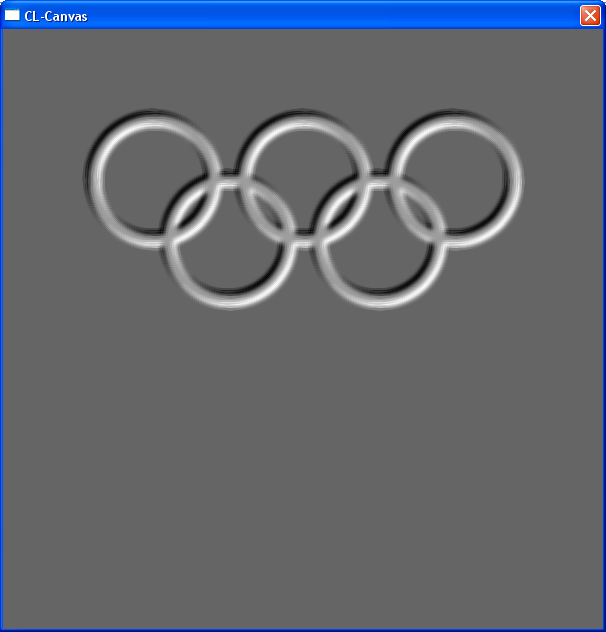
And here are the definition of paint and the other functions:
(defun circle (&key x0 y0 radius line-width)
(lambda (x y)
(let ((xc (- x x0))
(yc (- y y0)))
(let ((r2 (sqrt (+ (* xc xc) (* yc yc)))))
(if (and (>= r2 (- radius line-width))
(< r2 (+ radius line-width)))
1.0
0.0)))))
(defun convolution (&key function matrix sample-radius divisor)
(lambda (x y)
(let ((sum 0.0))
(loop for xo from -1 to 1 do
(loop for yo from -1 to 1 do
(incf sum (* (aref matrix (1+ yo) (1+ xo))
(funcall function
(+ x (* sample-radius xo))
(+ y (* sample-radius yo)))))))
(setf sum (/ sum divisor))
sum)))
(defun blur (&key function sample-radius)
(convolution :function function
:matrix '#2a((0.7 1.0 0.7)
(1.0 1.0 1.0)
(0.7 1.0 0.7))
:sample-radius sample-radius
:divisor 9.0))
(defun emboss (&key function sample-radius)
(convolution :function function
:matrix '#2a(( 1.0 0.7 0.0)
( 0.7 0.0 -0.7)
( 0.0 -1.0 -0.7))
:sample-radius sample-radius
:divisor 1.0))
(defun add (&rest functions)
(lambda (x y)
(let ((sum 0))
(loop for function in functions do
(incf sum (funcall function x y)))
sum)))
(defun black-white (&key function limit)
(lambda (x y)
(if (> (funcall function x y) limit)
1.0
0.0)))
(defun paint (function)
(let ((data (make-array (list clc:*height* clc:*width*)))
(min-date 1.0e10)
(max-date -1.0e10))
(loop for y from 0 below clc:*height* do
(loop for x from 0 below clc:*width* do
(let ((date (funcall function
(- (* (/ x clc:*width*) 2) 1.0)
(- (* (/ y clc:*height*) 2) 1.0))))
(setf (aref data y x) date)
(when (< date min-date) (setf min-date date))
(when (> date max-date) (setf max-date date)))))
(loop for y from 0 below clc:*height* do
(loop for x from 0 below clc:*width* do
(let ((normalized-date (/ (- (aref data y x) min-date)
(- max-date min-date))))
(let ((c (round (* 256 normalized-date))))
(when (> c 255) (setf c 255))
(when (< c 0) (setf c 0))
(setf (clc:framebuffer-point x y)
(logior c (ash c 8) (ash c 16)))))))
(clc:repaint)))